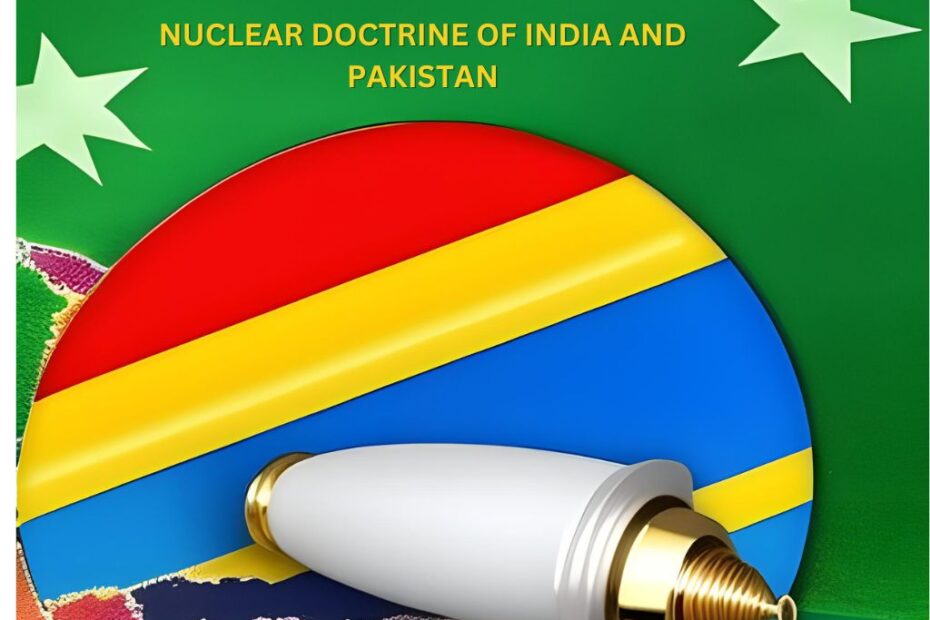Contents
Comparison of Nuclear Doctrine of India and Pakistan
Nuclear doctrine means the goals and principles that guide a state to use the nuclear weapons. Both India and Pakistan has its own sets of principle regarding the use of Nuclear weapon. Comparison of nuclear doctrine of India and Pakistan gives a clear picture of the nuclear doctrine of both the countries and existing differences and similarities between their nuclear doctrines.
Nuclear Doctrine of India:
- . Credible Deterrence: India aims to maintain a minimal but effective deterrence against potential nuclear threats.
- No First Use: India has declared not to be the first to initiate a nuclear war and will only use nuclear weapons as a response to a nuclear attack on its soil or anywhere on its armed forces.
- Massive Retaliation: In the event of a nuclear attack on India, the response would be designed to inflict massive and unacceptable damage.
- Civilian Control: Nuclear attack can only be authorized by the official civilian leadership, who approve the action through the Nuclear Command Authority.
- Restrained Use: India does not use nuclear weapons against nations with nuclear capability. However, in the case of a significant biological or chemical attack, a nuclear reaction remains an option.
- Export Controls: India maintains strict controls on exports of nuclear and missile related material and technology. It participates in agreements that result from the observance of the Metallurgical Equipment Limit Cut Treaty and the Moratorium on Nuclear Tests.
- Aim of Suspicion: India aims towards a nuclear weapons free world and has a commitment to reach that through global, verifiable and non-discriminatory nuclear disarmament.
- Nuclear Command Structure: The Nuclear Command Authority consists of a Political Council and an Executive Council. The Political Council is headed by the Prime Minister and the Executive Council is headed by the National Security Advisor. The Political Council has the sole authority to authorize the use of nuclear weapons.
- Assessment of preparedness: The Council of Ministers for Security (CCS) examined the preparedness, target strategy and command structure. The Security Council confirmed the adequacy of preparedness, approved a Chief Commander for the Strategic Forces Command, and provided alternative command chains for retaliation.
In summary, India’s nuclear strategy reflects a balanced approach to nuclear capability on deterrence, response and global disarmament.
Nuclear Doctrine of Pakistan:
- Credible Minimum Deterrence: Pakistan’s nuclear strategy revolves around maintaining a credible minimum deterrent against technology belligerents.
- Full Detail Deterrence: Pakistan’s policy includes the notion of “Full Detail Deterrence”, which means it will be prepared to face nuclear and conventional threats at various levels of conflict.
- First Use and Intensification: Like India, Pakistan follows a “no first use” policy. It reserves the right to respond to a conventional military attack that threatens its military capability or capability that could threaten its land security or statehood.
- Counterforce and Counter Value Targets: Pakistan’s nuclear policy includes the option of neutralizing (targeting the enemy’s military capabilities) and delivering (targeting cities and civilian population centers) general military capabilities.
- Nuclear Response Option: Pakistan’s response to a nuclear attack would be large and significant to the aggressor, such that the value of the benefits gained by the aggressor outweighs the risk.
- Command and Control: Pakistan has established a centralized command and control system to manage its nuclear deterrence. The National Command Authority (NCA), headed by the Prime Minister, presides over all nuclear matters.
- Preventing Nuclear Terrorism: Pakistan attaches great importance to the security of its nuclear assets and their unauthorized use or access by terrorist groups.
- Not for use against non-nuclear states: Like India, Pakistan It recognizes the commitment not to use nuclear weapons against non-nuclear states.
- Abolition and Regional Stability: Pakistan attaches importance to its commitment to global nuclear abolition and achieving peace and stability. It intersects with credibility with various arms control measures and terrorism.
- Strategic Stability: Pakistan attaches importance to maintaining strategic stability in the region and avoiding an arms race. It believes that maintaining the balance of power is vital to regional security.
- Minimum Nuclear Limitation: Pakistan’s policy indicates that it will use nuclear weapons only when the deterrence of the capability is fatally defeated or when a significant existential threat arises.

Comparison of Nuclear Doctrine of India and Pakistan
Comparison of Nuclear Doctrine of India and Pakistan
Pakistan’s nuclear policy draws from its security concerns and historical conflict with India. At the same time India has its own policies based on its historical events, national morale, and political leadership. There are some differences and similarities between the nuclear doctrine of India and Pakistan.
Differences between the Nuclear Doctrine of India and Pakistan
The nuclear policies of India and Pakistan differ significantly because of their historical, geographical and strategic calculus.
- No First use and conditional first use:
– India: Follows a “no first use” policy, which states that it will not be the first to use nuclear weapons, only retaliatory to a nuclear attack on its soil or armed forces.
– Pakistan: There is no “first use arrest” policy. It already reserves the right to use nuclear weapons in response to conventional attacks threatening its ecological conflict that question its land security or statehood.
- Vengeance and Response:
– India: Emphasizes retaliation specifically against a nuclear attack, which is intended to inflict unacceptable harm on the aggressor.
– Pakistan: Supports a mix of counterforce and countervalue targets coupled with a willingness to respond to various levels of conflict, including military strikes.
- Maintaining full expansion deterrence and reliable minimum deterrence:
– India: focuses on “full-scale deterrence”, which includes preparedness to oppose nuclear and conventional threats equally in all levels of conflict.
– Pakistan: Expresses willingness to support maintaining credible minimum deterrence against its adversaries, so as to have the capability to respond at various levels of conflict.
- Command and Control:
– India: Uses a dual-key system, in which both the moral and military leadership are involved in decision making. Prime Minister as the head of the Nuclear Command Authority gives final permission.
– Pakistan: Uses a centralized command and control system, in which the National Command Authority, headed by the Prime Minister, supervises all nuclear matters.
- Non-Nuclear Pledge:
– India: commits not to use nuclear weapons against non-nuclear amateur states.
– Pakistan: Not a specific non-nuclear pledge, but has indicated it will not be the first to introduce nuclear weapons in South Asia.
- Revocation Attempts:
– India: moves in favor of global, verifiable and indivisible nuclear abolition.
– Pakistan: Supports global repeal but cites it as a major factor affecting its security concerns and regional balance.
- Acceleration Control:
– India: Strives to maintain control and avoid escalation into high level conflict.
– Pakistan: highlights the desire for aggression and intensification as a means of building power, in order to resist supremacy in penetration and power.
In short, although India and Pakistan share their security and stability concerns, their nuclear policies reflect divergent approaches based on their strategic and regional cues. India’s policy focuses on “first-use deterrence” and full-scale deterrence, while Pakistan’s policy is a mixture of conditional first-use and credible minimum deterrence, with a willingness to respond to conflict of varying levels.
Similarities between the Nuclear Doctrine of India and Pakistan
In spite of many differences in the nuclear policies of India and Pakistan, there are also some similarities in their approaches because of their shared regional security concerns and the need for deterrence. Following are some of the important similarities between the nuclear policies of India and Pakistan:
- Deterrence and Security:
Both India and Pakistan recognize the importance of nuclear deterrence as a means of ensuring their national security and deterring potential aggression from adversaries.
- Commitment to Credible Deterrence:
Both India and Pakistan stress the need to uphold the commitment to credible deterrence, whether it is India’s “full-scale deterrence” or Pakistan’s “credible minimum deterrence”. It includes the capability and readiness to effectively respond to various threats.
- Control and Command Structures:
Both India and Pakistan have established centralized command and control structures to manage their nuclear assets. In India, the Nuclear Command Authority (NCA) supervises these matters, while in Pakistan the National Command Authority (NCA) acts as a supporting ground.
- Regional stability and non-use:
Both India and Pakistan value regional stability and oppose the use of nuclear weapons against non-nuclear states. This shows an awareness of the dangers that come with nuclear conflicts in their shared territory.
- Interference Control and Inference Prohibition:
While their policies differ in notions of first use, both India and Pakistan have a desire to avoid uncontrolled escalation of escalation and avoid conflicts turning into nuclear exchanges.
- Security of Nuclear Assets:
Both India and Pakistan attach importance to the security of their nuclear assets being authorized to prevent unauthorized access and potential terrorist conflicts.
- Balance of Power:
Both India and Pakistan recognize the importance of maintaining a balance of power in the region so that neither side gains excessive prominence.
Show your Love:https://daytodayfacts.com
